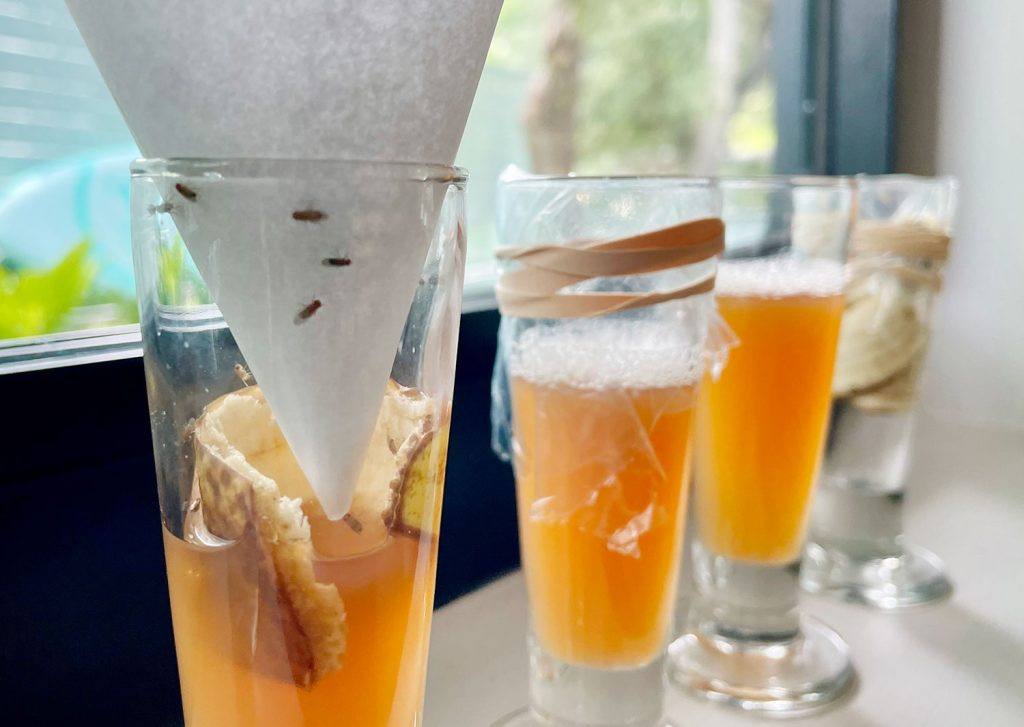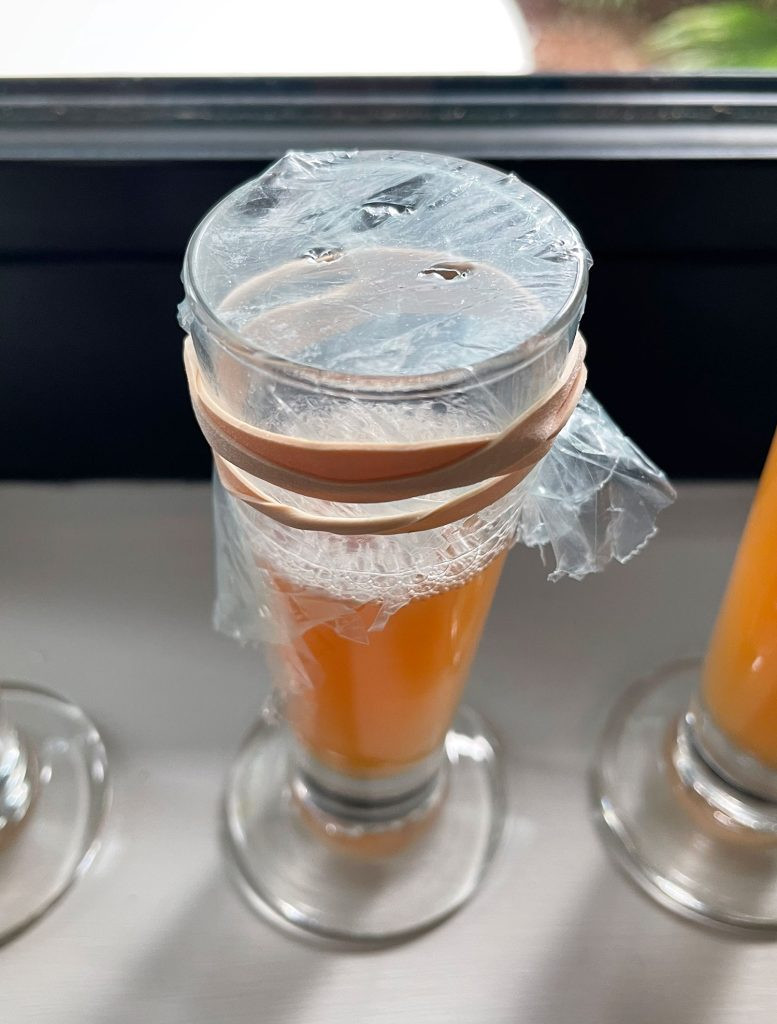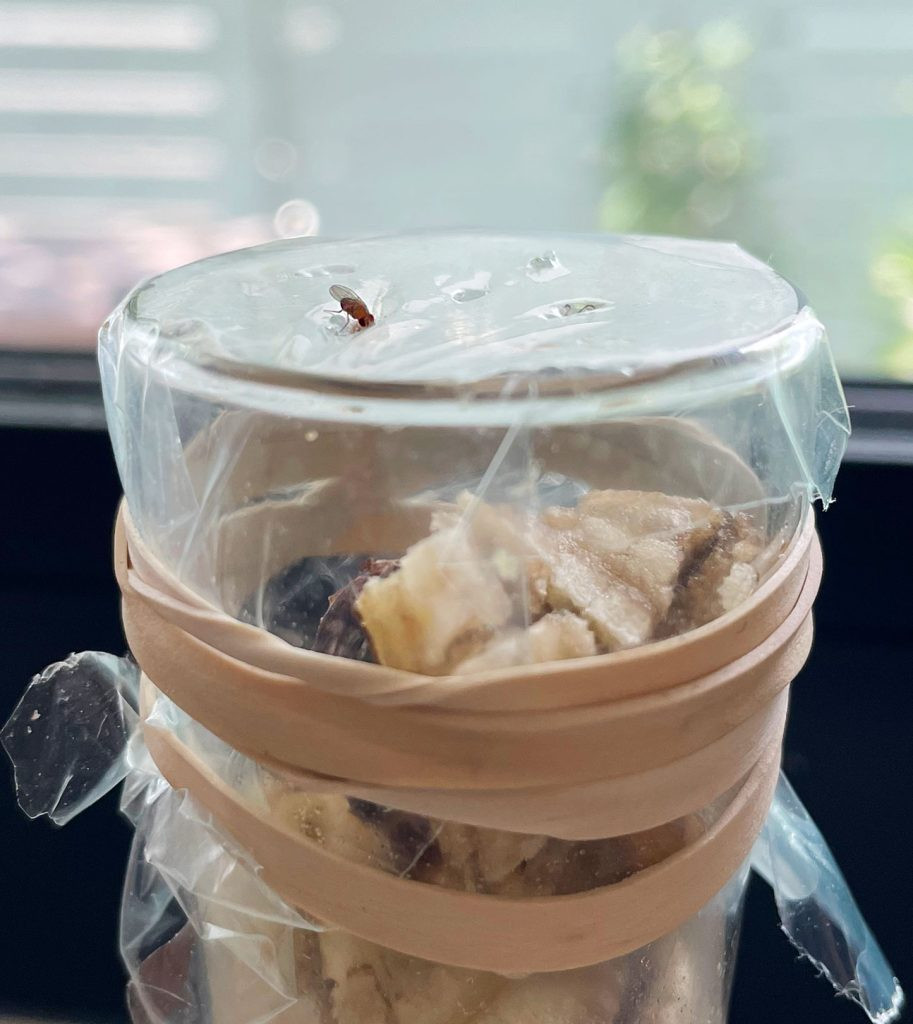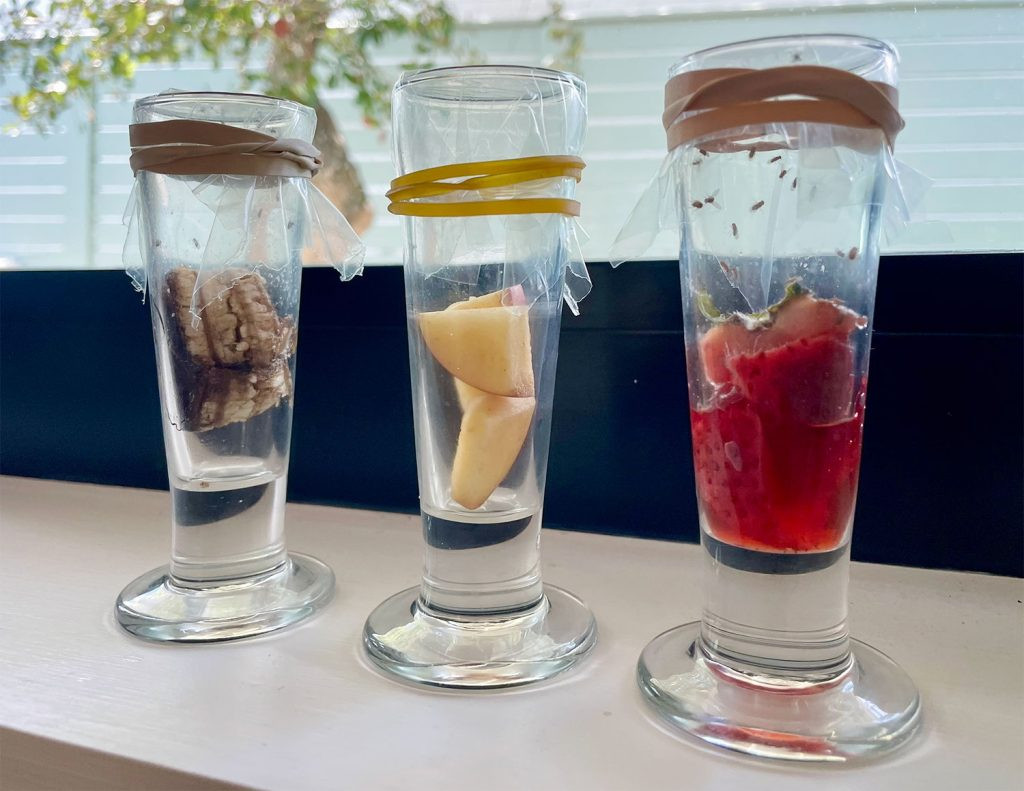Fruit fly infestation can be a nuisance, but don’t worry, flyermedia.net is here to help you tackle this problem with effective solutions. By implementing a few simple strategies, you can eliminate these pests and prevent future infestations. Keep reading to discover the best preventative measures and organic approaches to keep your home free from these annoying fruit flies, vinegar flies, and phorid flies.
1. What Exactly Are Fruit Flies?
Fruit flies are tiny pests commonly found buzzing around ripe fruits and vegetables. These minuscule insects, often mistaken for fungus gnats or drain flies, are drawn to the sweet, sugary surfaces of fruits, garbage disposals, and even fermented beverages. Knowing how to identify them is the first step in managing and preventing an infestation.
- Appearance: Fruit flies are small, typically tan or brownish, with red eyes, resembling miniature versions of houseflies.
- Habitat: They thrive in environments with decaying organic matter, such as overripe fruits, garbage cans, and damp areas.
- Reproduction: Female fruit flies can lay hundreds of eggs, which hatch in as little as 24 hours, leading to rapid population growth.
- Seasonal Occurrence: They are most prevalent during the warmer months when fruits are abundant.
 Fruit Flies Trapped In DIY Funnel Trap Method
Fruit Flies Trapped In DIY Funnel Trap Method
2. What’s the Difference Between Fruit Flies, Fungus Gnats, and Drain Flies?
It’s easy to mix up fruit flies with other small flying insects, but knowing the difference is key to getting rid of them effectively.
| Insect | Appearance | Habitat |
|---|---|---|
| Fruit Flies | Small, tan or brownish flies with red eyes | Near ripe fruit, garbage cans, and sugary substances |
| Fungus Gnats | Small, mosquito-like flies | Near houseplants, breeding in damp soil |
| Drain Flies | Small, fuzzy, moth-like flies | Near sinks, drains, and sewage areas |
- Fruit Flies: Resemble small flies and are often found near fruit bowls, trash cans, and other smelly food sources.
- Fungus Gnats: Look like small mosquitoes and are commonly found near houseplants, where they breed in damp soil.
- Drain Flies: Appear as small, fuzzy moths and are typically found near sinks, drains, and areas with sewage.
3. How to Create a DIY Fruit Fly Trap?
Creating a DIY fruit fly trap is an easy and cost-effective way to eliminate these pests from your home.
3.1. What Supplies Do I Need for a Homemade Fruit Fly Trap?
You’ll need just a few common household items:
- A small, clear jar, cup, or container
- Apple cider vinegar (ACV) or overripe fruit
- Dish soap
- Plastic wrap or paper/cardstock
- Rubber band
- Toothpick
- Scissors
- Tape
3.2. What is the Funnel Trap Method?
The funnel trap method lures fruit flies into a container using a paper funnel with a tiny opening, making it difficult for them to escape.
- Container Preparation: Choose a small, clear jar or container with a narrow opening.
- Attractant Addition: Pour a small amount of apple cider vinegar, old beer, or wine into the container to attract the fruit flies.
- Funnel Creation: Roll a piece of paper or cardstock into a cone shape, securing it with tape to maintain its form. The opening at the tip should be very small, about the size of a grain of rice.
- Funnel Placement: Place the paper cone into the container’s opening, ensuring it fits snugly without touching the liquid at the bottom.
- Trap Maintenance: Regularly check and empty the trap as needed. To humanely dispose of the trapped flies, carefully take the container outside, remove the funnel, and allow the flies to escape.
3.3. What is the Plastic Wrap Trap Method?
This trap uses plastic wrap with small holes to trap fruit flies inside the container.
- Container Selection: Choose a small, clear jar or cup.
- Attractant Addition: Pour a small amount of apple cider vinegar into the container.
- Plastic Wrap Covering: Tightly cover the opening with plastic wrap, securing it with a rubber band.
- Hole Creation: Use a toothpick to poke a few small holes in the plastic wrap, allowing flies to enter.
- Trap Maintenance: Regularly check the trap and dispose of the trapped flies. To release them humanely, remove the plastic wrap outdoors.
 DIY Fruit Fly Trap With Apple Cider Vinegar And Plastic
DIY Fruit Fly Trap With Apple Cider Vinegar And Plastic
3.4. What is the Dish Soap Trap Method?
This method uses dish soap to break the surface tension of the liquid, causing fruit flies to drown.
- Container Preparation: Select a small container, bowl, or dish.
- Attractant Addition: Pour apple cider vinegar into the bottom of the container.
- Soap Mixture: Add several drops of dish soap to the apple cider vinegar and mix to create a soapy solution.
- Trap Placement: Place the trap in areas where fruit flies are prevalent.
- Trap Maintenance: Regularly check the trap and clean out the dead flies.
3.5. What is the Rotting Fruit Trap Method?
This trap uses overripe fruit to attract fruit flies into a container.
- Container Selection: Select a small glass jar, cup, or container.
- Fruit Addition: Place a small piece of overripe fruit, such as a banana peel or apple slice, into the container.
- Covering: Cover the container with plastic wrap or a paper funnel, depending on the trap mechanism you choose.
- Trap Placement: Place the trap in areas where fruit flies are prevalent.
- Trap Maintenance: Replace the fruit every day or two to prevent unwanted odors and maintain the trap’s effectiveness.
 Fruit Fly Entering Plastic Wrap On DIY Trap
Fruit Fly Entering Plastic Wrap On DIY Trap
4. What’s the Best Fruit Fly Trap Recipe?
After conducting tests using plastic wrap traps with banana peel, funnel traps with ACV and banana peel, plastic wrap traps with ACV and soap, and dish soap traps with ACV, it became evident that the lure used significantly influenced the trap’s effectiveness. Traps baited with banana peel performed remarkably better than those using only apple cider vinegar. This suggests that fruit flies are more attracted to the scent of real fruit compared to ACV alone.
4.1. What Lure Works Best?
Adding a fruit scrap to any trap can enhance its effectiveness. For example, combining a banana peel with either the plastic wrap or funnel trap methods significantly improves their ability to attract and capture fruit flies. This finding emphasizes the importance of using appealing bait to maximize the success of DIY fruit fly traps.
4.2. What Traps Should You Use?
While the type of trap matters, the lure is more critical. The plastic wrap trap is easy to make and less prone to accidental disruption. To get the best results, add a fruit scrap like a banana peel to any trap you set up.
5. Which Fruit Attracts Fruit Flies the Most?
To determine the most effective fruit bait, we tested banana peels, apple slices, and strawberries in plastic wrap traps.
5.1. What Were the Results?
The fruit flies were most attracted to the strawberry. Although the banana peel started strong, the strawberry caught more flies as it rotted. Apple slices didn’t catch any.
5.2. How to Use These Results?
Use strawberries as bait in your DIY traps for the best results. The more it rots, the better it works.
 Fruit Fly Traps With Different Rotten Fruit Baits
Fruit Fly Traps With Different Rotten Fruit Baits
6. What Are Some Store-Bought Fruit Fly Traps?
If DIY isn’t your thing, or you want something more discreet, consider store-bought traps.
6.1. What Are the Benefits of Store-Bought Traps?
These traps are effective and can catch other flying insects. They are also more discreet than DIY traps.
6.2. How Effective Are Store-Bought Traps?
During our experiment, we tested Terro Traps alongside our homemade traps. Initially, the homemade strawberry and banana peel traps outperformed the store-bought trap. However, after discarding the DIY traps and leaving the store-bought trap for another 24 hours, it caught a significant number of fruit flies.
6.3. What’s the Verdict on Store-Bought Traps?
Store-bought traps work well, especially if you want something discreet. Homemade traps, however, may be the best way to get rid of fruit flies quickly.
 Terro Fruit Fly Apple Trap With No Fruit Flies In It
Terro Fruit Fly Apple Trap With No Fruit Flies In It
7. How Can I Prevent Fruit Flies From Infesting My Home?
Prevention is the best strategy. Here are some simple ways to keep fruit flies away:
- Clean Kitchen Surfaces: Wipe down kitchen counters, stovetops, tables, and other surfaces to remove food residue.
- Take Out Your Trash: Empty your trash cans regularly to prevent food scraps from becoming a breeding ground.
- Dispose of Overripe Fruit: Monitor your fruit bowl and dispose of overripe or rotting fruits.
- Wash Your Fruit: Wash your fruit as soon as you get it home to eliminate eggs or larvae.
- Store Produce in the Fridge: Store your fruit and vegetables in the refrigerator to prevent fruit flies from flourishing.
- Clean Your Sink Drain: Run your garbage disposal and flush the drain regularly to remove food scraps.
8. How Do Professionals Handle Fruit Fly Infestations?
Pest control professionals can employ several strategies to manage and eliminate fruit fly infestations. These approaches are typically more comprehensive and effective for severe or persistent problems.
8.1. What Inspection and Identification Methods Do Professionals Use?
Professionals begin by thoroughly inspecting the premises to identify breeding sites and the extent of the infestation.
- Detailed Inspection: Inspect potential breeding areas such as kitchens, pantries, and garbage areas.
- Species Identification: Determine if the infestation is caused by fruit flies, drain flies, or fungus gnats, as each requires a specific treatment strategy.
8.2. How Do Professionals Treat Breeding Sites?
Identifying and treating breeding sites is crucial for long-term control.
- Sanitation Practices: Implement rigorous cleaning protocols to eliminate food sources.
- Drain Treatment: Use enzymatic cleaners to remove organic buildup.
- Insect Growth Regulators (IGRs): Apply IGRs to disrupt the life cycle of fruit flies.
8.3. What Chemical Treatments Can Professionals Use?
While less common due to the focus on source reduction, professionals may use targeted chemical treatments when necessary.
- Space Sprays: Apply quick-acting insecticides to kill adult fruit flies.
- Residual Sprays: Use insecticides that leave a residue on surfaces to kill flies upon contact.
8.4. What Follow-Up and Prevention Strategies Do Professionals Recommend?
Professionals provide ongoing recommendations to prevent future infestations.
- Regular Cleaning Schedules: Implement regular cleaning schedules to prevent food buildup.
- Proper Food Storage: Store fruits and vegetables in airtight containers.
- Drain Maintenance: Regularly clean drains and garbage disposals.
9. What are the Natural Predators of Fruit Flies?
While you might not want to introduce more insects into your home, knowing about the natural predators of fruit flies can be helpful in understanding how to manage their populations in a more holistic way, particularly in gardens or outdoor areas.
9.1. What Insects Prey on Fruit Flies?
- Parasitic Wasps: These tiny wasps lay their eggs inside fruit fly larvae, eventually killing them.
- Predatory Mites: Certain mites feed on fruit fly eggs and larvae.
9.2. How Can You Encourage These Predators?
- Avoid Broad-Spectrum Pesticides: These can harm beneficial insects.
- Provide Habitat: Create environments where these predators can thrive, such as gardens with diverse plant life.
9.3. Are There Other Natural Methods for Controlling Fruit Flies?
- Diatomaceous Earth: This natural substance can be sprinkled around areas where fruit flies are present to dehydrate and kill them.
- Essential Oils: Certain oils like lavender and peppermint can repel fruit flies.
10. What Are Some Common Mistakes People Make When Trying to Get Rid of Fruit Flies?
When dealing with a fruit fly infestation, it’s easy to make mistakes that can prolong the problem. Here are some common pitfalls to avoid:
- Ignoring Breeding Sites: Focusing only on adult flies without eliminating breeding sites allows the infestation to persist.
- Using Ineffective Traps: Not using the right attractants or trap designs can render them useless.
- Neglecting Sanitation: Failing to clean up food residues and spills provides an ongoing food source.
- Overusing Pesticides: Relying too heavily on pesticides can create resistance and harm beneficial insects.
10.1. How Can You Avoid These Mistakes?
- Thorough Inspection: Always start with a thorough inspection to identify all potential breeding sites.
- Effective Traps: Use proven trap designs and the most attractive baits.
- Consistent Sanitation: Maintain a rigorous cleaning schedule.
- Balanced Approach: Combine sanitation, trapping, and minimal pesticide use.
Dealing with fruit flies can be frustrating, but with the right strategies, you can eliminate them and prevent future infestations. Remember to focus on cleanliness, use effective traps, and consider professional help if the problem persists.
Remember, tackling a fruit fly infestation requires a combination of prevention, trapping, and consistent sanitation.
At flyermedia.net, we’re committed to providing you with the latest information and resources to help you navigate the world of aviation. Whether you’re looking for flight training, aviation news, or career opportunities, we’ve got you covered.
Ready to take your aviation journey to the next level? Visit flyermedia.net today to explore our comprehensive guides, news updates, and job listings. Fly high with flyermedia.net
Address: 600 S Clyde Morris Blvd, Daytona Beach, FL 32114, United States
Phone: +1 (386) 226-6000
Website: flyermedia.net
FAQ About Fruit Flies
1. What are fruit flies attracted to?
Fruit flies are attracted to ripe and rotting fruits and vegetables, sugary liquids, and fermented beverages.
2. How quickly can fruit flies reproduce?
Female fruit flies can lay hundreds of eggs, which hatch within 24 hours, leading to rapid population growth.
3. Are fruit flies harmful to humans?
Fruit flies are generally harmless to humans, but they can contaminate food and spread bacteria.
4. How can I prevent fruit flies from entering my home?
You can prevent fruit flies by cleaning kitchen surfaces, disposing of overripe fruit, washing fresh produce, and storing food in airtight containers.
5. What is the best homemade fruit fly trap?
The best homemade fruit fly trap typically involves a container with apple cider vinegar and dish soap, or a container with overripe fruit covered with plastic wrap.
6. Can fruit flies breed in drains?
Yes, fruit flies can breed in drains where organic matter accumulates. Regularly cleaning drains can help prevent this.
7. Do fruit flies bite?
No, fruit flies do not bite humans. They are primarily a nuisance because of their attraction to food and sugary substances.
8. How long do fruit flies live?
Fruit flies typically live for about 40 to 50 days.
9. What essential oils repel fruit flies?
Essential oils like lavender, peppermint, and eucalyptus can help repel fruit flies.
10. When should I call a professional for fruit fly control?
If you have tried various methods to eliminate fruit flies and the infestation persists, it may be time to call a professional pest control service.